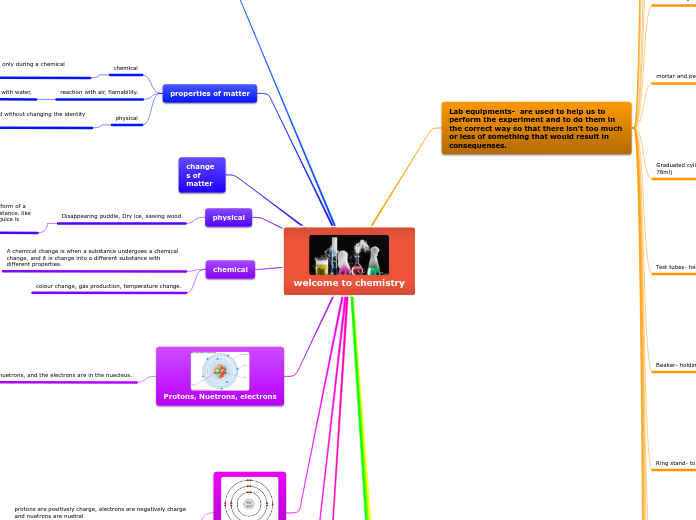welcome to chemistry
Lab equipments- are used to help us to perform the experiment and to do them in the correct way so that there isn't too much or less of something that would result in consequenses.
Erlenmeyer flask- is used to measure, mix, and hold liquids in the lab.
Erlenmeyer flask
Evaporating dish- used to evaporate a liquid so that we can get the solid back.
Evaporating dish
Watch glass- is used to evaporate liquids, hold substances for heating/ weighing, cover for beaker
Watch glass
Facts
Wire mesh with ceramic center- flame shield, hold beakers over a flame
Wire mesh with ceramic center
Forceps- move, grasp, hold, items that shouldn't be touched and is also used in dissection
Forceps
Ring clamp- hold glassware over a flame
Ring clamp
Apron- to protect clothing
Apron
crucible- used for heating/ holding chemicals that are very hot
Crucible
Bunsen burner- used for heating, sterillization and combustion and is also an alternative to hot plate
Bunsen burner
Ruler- measuring length for quantitive observation
Ruler
Beaker tongs- lifting/ carrying/ heating beakers
Beaker tongs
mortar and pestle- crush substances into a fine paste/ powder
Mortar and pestle
Graduated cylinder- used to measure volume exactly, (ex. 78ml)
Graduated cylinder
Test tubes- heat small amount of liquids or solids
Test tubes
Beaker- holding/ mixing liquids, not exact amounts
Beaker
Ring stand- to hold the ring clamp
Ring stand
scoopula- used for transferring small amount of granulated chemicals from jars to beakers
Scoopula
Test tube holder- lifting/ carrying hot test tubes
Test tube holder
Test tube rack- holds many test tubes at once, drying rack
Test tube rack
Pipette- transports really small amount of liquids (drops)
Pipette
Thermometer- measure temperature/ changes with a high degree of precision
Thermometer
Funnel- pour liquids into a small opening filtering
Funnel
Glass stirring rod- to mix chemicals
Glass strirring rod
Clay triangle- used for heating a crucible evenly over a bunsen burner
Clay triangle
Main topic
steps of the scientific method
1. purpose- the question that we are asking or the reason for the experiment.
2. Hypothesis- an educated guess of what we think might happen.
3. Materials- the equipments that we need to do the experiment
4. procedure- carry out the experiment
5. Result- analyze the observations
6. Conclusion- make a conclusion of what the experiment is about.
we use the scientific method to help us to understand how to do a science experiment.
Naming compounds
compounds with metals
LiCL- Lithium chloride
first element keeps its name, second element ends in ''ide''
compounds without metals
SO2 sulfure dioxide
use a prefix to figure out how many atoms there are
periodic table
the periodic table has 118 elements, which has metals, non- metals, and metalloids. and is organized in groups 1-18.
properties of matter
chemical
A property that can be observed only during a chemical change.
reaction with air, flamability.
reaction with acid, reaction with base, reaction with water,
physical
A property that can be observed without changing the identity of the substance.
Ex. odor, density, structure, hardness, solubility
changes of matter
physical
Disappearing puddle, Dry ice, sawing wood
A physical changes is when somethng changes the form of a substance, but it does not change into another substance. like for example, making orange juice, the state of the juice is changed, but not the properties of it.
chemical
A chemical change is when a substance undergoes a chemical change, and it is change into a different substance with different properties.
colour change, gas production, temperature change.
Protons, Nuetrons, electrons
the protons, nuetrons, and the electrons are in the nuecleus.
Bohr diagram
protons are positively charge, electrons are negatively charge and nuetrons are nuetral
protons and nuetrons are found in the nuecleus and electrons are found ouside of the nuecleus
Whimis
there are 10 WHIMIS safety symbols
Pure substances vs. mixtures
Pure substances - made up of only one type of particle
Elements - made up of only one type of atom Ex. Hydrogen
Compounds- made up of two or more different atoms bonded together Ex. Salt
Mixtures- made up of two or more different types of particles
Heterogeneous mixtures- more than one part of the mixture is visible Ex. Pizza
Homogeneous mixtures- only one part of the mixture is visible Ex. Millk
